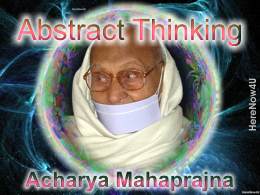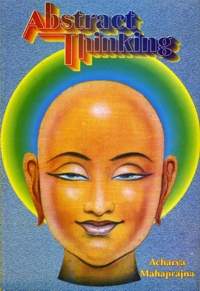
In this world, only those people are bound by karma who have no discrimination. Only those people have realized the soul, whose sense of discrimination is fully developed, and in whom the unconscious has been brought into the field of the conscious.
As the knowledge of the fundamental soul and the distinction between the cycles formed in its vicinity becomes clear, the bondage of karma gradually loosens of itself. Those who are devoid of discrimination and look upon the basic consciousness and the folds of consciousness as being one - their bondage becomes even more intense. The karmic particle is unconscious, inanimate. That which is unconscious can never become one with the conscious. It is our passion-ridden soul, which, through the medium of the karmic body, mixes the unconscious with the conscious. With the soul that is free, the material particle can never assimilate, because a free soul consists of nothing but pure awareness. In the moment of directly experiencing pure consciousness, the exercise of inhibition, or restraint, in the presence of the karmic body, stalls any relationship with the karmic material particles; and in the absence of the karmic body, it partakes of the nature of the soul. The moment of experiencing the passion-inflicted consciousness is the moment of influx, which attracts the karmic material particles. The principle of affinity functions here. Like attracts like. The transformations of passion-afflicted consciousness are mixed with material particles. One material particle draws another. If we grasp this fact, it would prove to be a strong foundation for self-realization. Let us practice living more and more in moments of pure consciousness, where there is only knowledge, devoid of sensation. This is the highest stage of sadhana. That is why the Jain Acharyas have used the word 'Pure Application' for meditation. 'Pure Application' means the experiencing of pure consciousness.
Through renunciation the consciousness of restraint is activated. Through the consciousness of restraint, one attains to perfect solitude. The sadhak feels that it is better to live within himself. The mind is tied to the peg within. It enjoys taking dips in the pacific ocean of consciousness. The mind is so much attracted by inner splendour that it does not want to stir into the darkness outside; it wants to keep within. In such a situation a great conflict arises. The influxes within, the inner instincts, and internal impulses get involved in conflict. Remissness and sensual passions start working. Infatuation, too, is activated. Both attachment and aversion begin strengthening their lines of defence. A dreadful battle ensues. This provides an opportunity for the sadhak. In Acharanga it is said:
“The occasion provided by this battle is a rare one."
The sadhak has to take up a strategic position. This is a great opportunity. He must profit by it. Such an opportunity comes but seldom. On one side he is invaded by attachment and aversion; on the other side he is assailed by their troops-frenzy, remissness and passions. Only by vanquishing them, can the sadhak make any progress. Only by annihilating them can he achieve individuality. When the sadhak reaches that stage, he wonders why he should perceive the breath, or the psychic centres, why observe a fast, or practise self-control - why all this bother? There lies the simple and direct route to self-realisation - the knower - only, the-seer-only, the spectator-approach. The path appears to be simple and direct to one who has arrived. But to one who has not yet arrived, it appears to be very devious and difficult. He has to struggle hard at every step. He finds himself assailed on all sides. Without repulsing all those attacks, he cannot move a step forward. One does not experience all this in the early stages of sadhana. In the initial stages, the influxes do not feel so threatened as to be obliged to give up their station. Nor do all the instincts feel similarly endangered. But when the sadhak begins to advance with great, determination, and begins to attack all those influxes and instincts, tries to give up the enduring influxes, all of them begin to hiss like a serpent enraged, because the sadhak has made an attempt which irritates them. As long as they are left undisturbed, they carry on their task quietly enough. But the moment they feel irritated, they become enraged and begin to hiss and frighten the sadhak. The serpent lies peacefully in its hole. You pass by; the snake does not hiss. But if you tease it, it gets enraged and runs out to sting you. The same applies to the influxes and the instincts. It is not easy to make them give up their places which they have eternally occupied since the beginning of time. As the sadhak gradually progresses ahead, the age-old instincts grow sharper. When the sadhak is midway through his sadhana, all the accumulated urges and passions come to the fore with such vehemence as to utterly demoralise the sadhak. If at such a time, the sadhak can find no helper, he goes astray. At that time, he greatly needs a capable guru or helper. That is for him a very critical hour. For what kind of instincts may arise at that time, cannot be imagined. Strange instincts arise to make the sadhak utterly restless. It is not that such instincts never arise. It is the experience of all sadhaks that in the very middle of their sadhana, the instincts grow sharper. It is very necessary to control them.
 Acharya Mahaprajna
Acharya Mahaprajna

